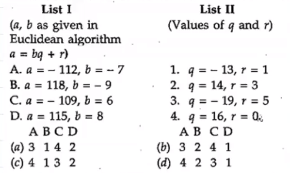List -I SaltList -II Kg(A)AgCIP.27S4(B)PbI2Q.108(S)5(C)AS2S3R.4S3(D)Ag3PO4S.S2Solution in Telugu
The correct Answer is:A-S;B-R;C-Q;D-P
Step by step video, text & image solution for {:("List -I Salt","List -II Kg"),((A) AgCI,P.27S^(4)),((B)PbI_(2),Q.108(S)^(5)),((C )AS_(2)S_(3),R.4S^(3)),((D)Ag_(3)PO_(4),S.S^(2)):} by Chemistry experts to help you in doubts & scoring excellent marks in Class 12 exams.
Topper's Solved these Questions
- BOOK - AAKASH SERIESCHAPTER - IONIC EQUILLIBRIUMEXERCISE - PRACTICE SHEET (EXERCISE-I ) LEVEL -I ( Straight Objective Type Questions )15videos
IONIC EQUILLIBRIUM
- BOOK - AAKASH SERIESCHAPTER - IONIC EQUILLIBRIUMEXERCISE - PRACTICE SHEET (EXERCISE-I ) LEVEL -II ( Straight Objective Type Questions )19videos
IONIC EQUILLIBRIUM
- BOOK - AAKASH SERIESCHAPTER - IONIC EQUILLIBRIUMEXERCISE - LECTURE SHEET ( EXERCISE-III) ( Straight Objective Type Questions)33videos
IONIC EQUILLIBRIUM
- BOOK - AAKASH SERIESCHAPTER - GROUP 17 ELEMENTSEXERCISE - EXERCISE - 3.238videos
GROUP 17 ELEMENTS
- BOOK - AAKASH SERIESCHAPTER - METALLURGYEXERCISE - EXERCISE - 7.223videos
METALLURGY
Similar Questions
Of the given anions, the strongest Bronsted base is
06:46View SolutionWhich of the following is strong Lewis acid?
02:47View SolutionBuffer capacity of acidic buffer solution is maximum when
(1) PH=Pk (2) [salt ]= [acid ] (3) pK=7 (4) [H+]=Pk02:03View SolutionWhy elements of group 17 are called halogens?
02:39View SolutionMetal sulphides occur mainly in rocks, but metal halides occur in lakes and sea. Why ?
View SolutionMatch List I with list II and select the correct answer:
 View Solution
View SolutionList-I contains angles in radians and List-II contains the quadrant in which the angle lies.
∣∣ ∣ ∣ ∣ ∣ ∣∣List-IList-II(P)2c(1)I(Q)4c(2)II(R)6c(3)III(S)7c(4)IV∣∣ ∣ ∣ ∣ ∣ ∣∣02:37View SolutionThe following are the steps in finding the matrix B, if B+(2345)=(5432). Arrange them in sequential order.
(A) ∴(pqrs)+(2345)=(5432)
(B) Let B=(pqrs)
(C) (p+2q+3r+4s+5)=(5432)
(D) P+2=5,q+3=4,r+4=3,s+5=2
⇒p=3,q=1,r=−1,s=−3
(E) ∴B=(31−1−3)01:31View SolutionMatch List-I with List-II and chose the correct answer from the code {:("List-I Electrolyte","List-I Solubility product"),(a.Bi_(2)S_(3),i.4s^(3)),(b.CdS,ii. 27s^(2)),(c.AI(OH)_(3),iii.108s^(5)),(d.CaF_(2),iv.s^(2)):}
00:49View SolutionMatch the stoichiometric coefficients listed in Column II with the species listed in Column I that are involved in the balanced equation of the reaction : {:(,"LIST -I",,"LIST -II"),((P),FeC_(2)O_(4),(1),10),((Q),MnO_(4)^(-),(2),24),((R),H^(+),(3),5),((S),CO_(2),(4),3):}
07:00View SolutionMatch the following : {:(,"LIST -I",,"LIST -II"),((P),K_(4)[Fe(CN)_(6)] to Fe^(3+) + CO_(2)+NO_(3)^(-),(1),61),((Q),FeS_(2) to Fe^(3+) +SO_(2),(2),11),((R),Br_(2)+2NaOH to NaOBr+NaBr+H_(2)O,(3),28),((S),As_(2)S_(3) to As^(+5)+SO_(4)^(2-),(4),5//3):}
04:15View SolutionList-I List-II In the aqueous medium the ion can be(A)HPO−24P.Arrhenius acid(B)CO−23Q.Bronstead base(C)H2PO−13R.Amphoteric(D)H2PO−12S.Bronstead acid
04:14View SolutionList-I List-II(A)SiF4P.Lewis acid(B)CO2Q.Lewis base(C)SO2R.Bronstead acid(D)NH3S.Bronstead base
03:50View Solution{:(" List-I "," List-II "),("1) Argentite ","a) KCl"),("2) Horn silver ","b) AgCl"),("3) Ruby silver ","c) "Ag_(2)S),("4) Sylvine ","d) "2Ag_(2)S.Sb_(2)S_(3)):}
04:43View SolutionMatch the complexed listed column −I with type of hybridisation listed in column −II and select the correct answer using the code given below the lists :
Column−IColumn−II(a)[AuF4]−(p) dsp2hybridisation(b)[Cu(CN)4]3−(q) sp3hybridisation(c)[Co(NH3)6]3+(r) sp3d2hybridisation(d)[Fe(H2O)5NO]2+(s) d2sp3hybridisation01:58View Solution

